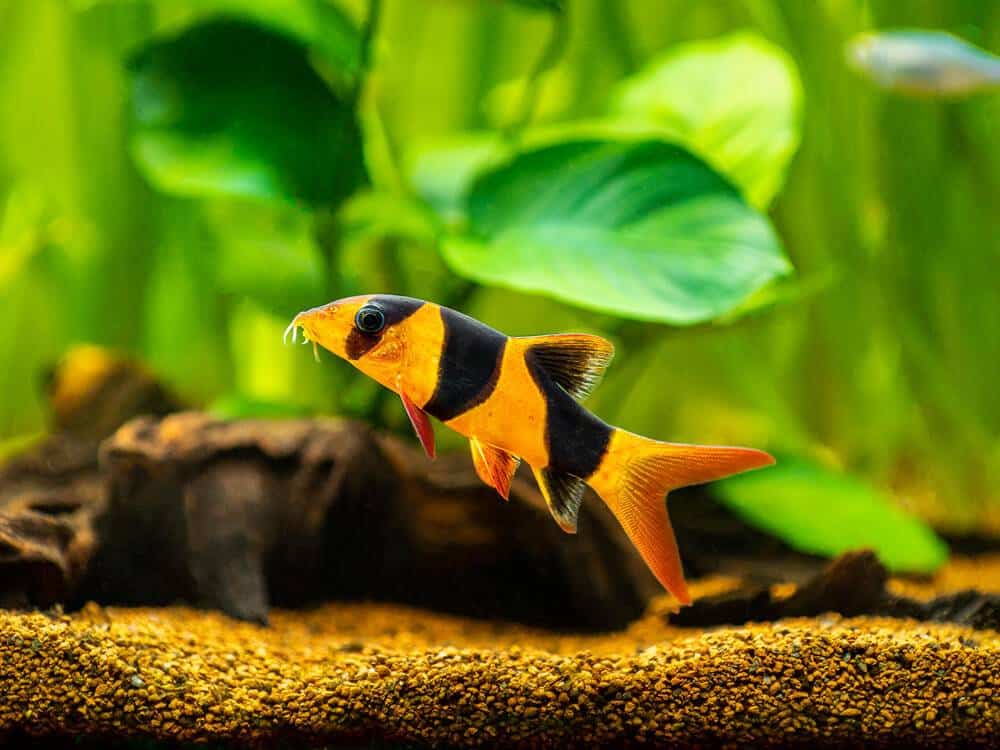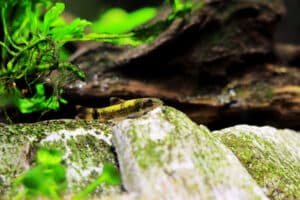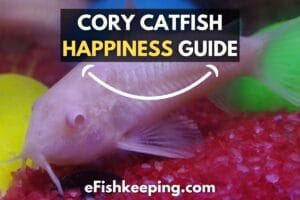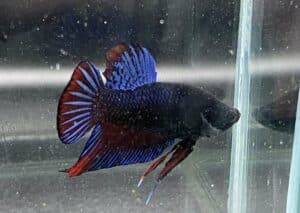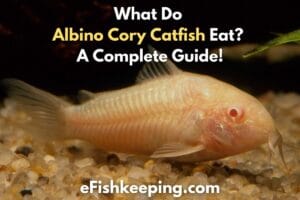I have been keeping clown loaches in my home tanks for a few years now, so I am confident that I can provide you with the right guidance on whether or not they eat algae.
Here’s the thing:
Clown loaches do not eat algae in the tank. However, they will happily munch on algae wafers because they are omnivores and they eat both vegetation and animal matter. What they really help with is controlling any snail population in the tank.
Keep reading until the end as I will delve into some of my experiences keeping clown loaches in the tank, what to feed them, and how they can help you keep the tank clean.
Why Can’t Clown Loach Eat Algae From The Tank?
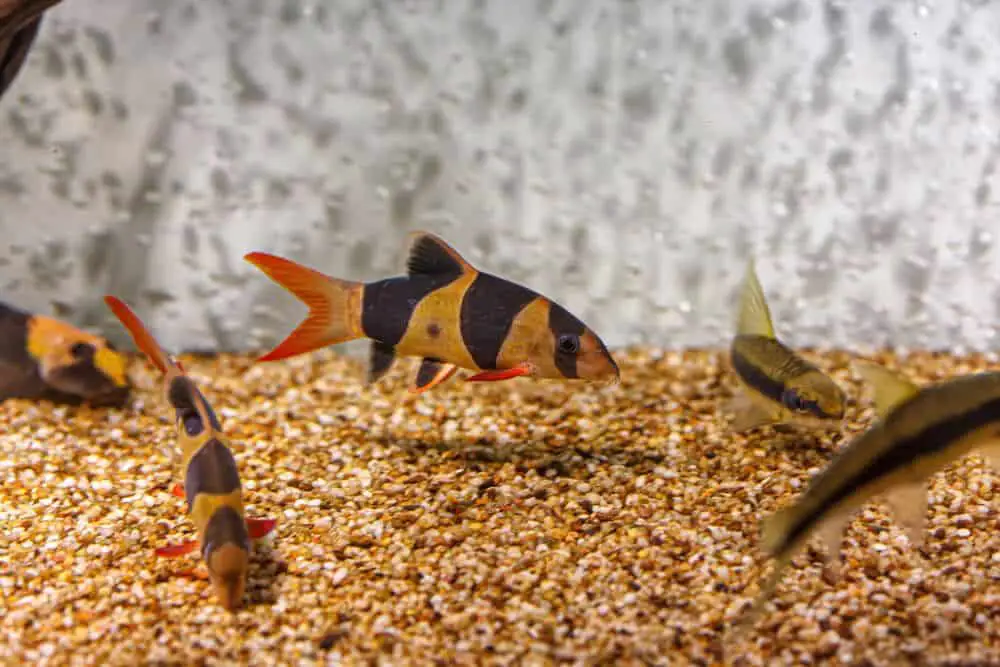
Clown loaches are a popular choice among aquarium enthusiasts due to their vibrant colors and interesting behavior. However, if you’re looking for an algae cleaner fish, then clown loach will not be a good fit for sure.
Even though they are a lively addition to your tank, clown loaches still demand regular maintenance just like any other fish.
The main reason why clown loaches can’t eat algae lies in their mouth structure. If you notice, algae eating fish mostly have a sucking type of mouth.
Unfortunately, the mouth structure of clown loaches is not built that way. They have a downward protruded mouth that is mostly built for finding food from the bottom and eating it. This makes them ineffective at removing algae from the tank surfaces.
To further understand this, let’s compare the mouth structure of clown loach with other algae eaters like a pleco fish. Plecos have a flat, sucker-like mouth that allows them to efficiently scrape algae off surfaces. Their mouth structure is perfectly suited for this task, unlike the clown loach.
If you’re in search of the best algae eaters for your tank, here are some popular choices:
- Siamese Algae Eater: These fish are known for their algae-eating prowess, especially when it comes to the dreaded black beard algae.
- Amano Shrimp: They are small, hardy shrimp that love grazing on various types of algae, including green algae, hair algae, and diatoms.
- Nerite Snails: These small, attractive snails are great algae eaters that can clean algae off surfaces without damaging plants.
Related Guide: Do Otocinclus Clean Glass?
Do Clown Loaches Clean The Tank?
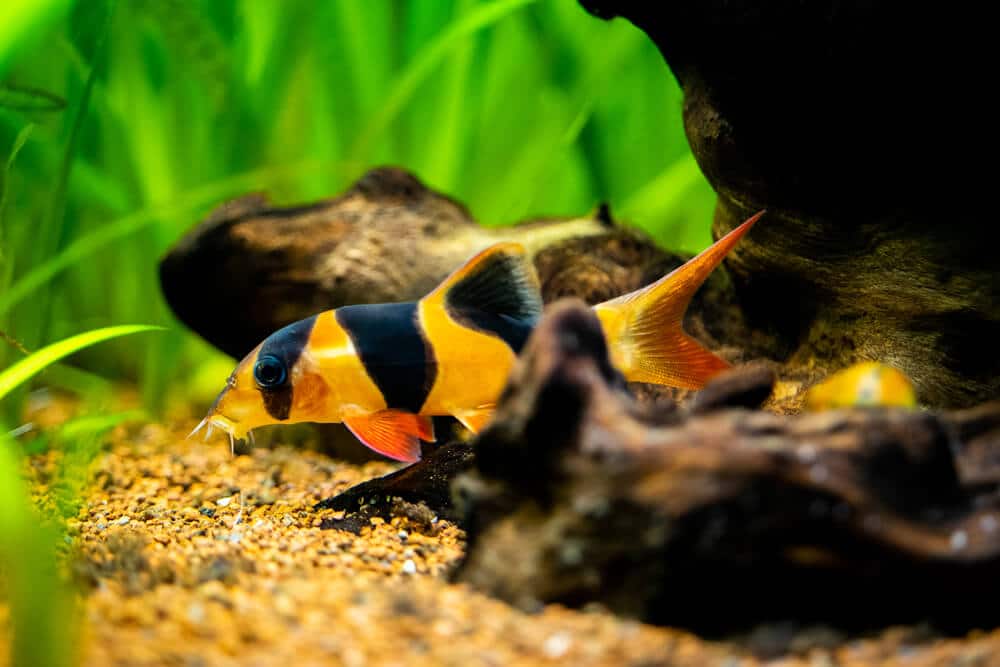
While it’s true that clown loaches don’t eat algae, they can still contribute to keeping your tank clean in other ways. Clown loaches are known for their ability to clean up leftover food and debris that gets trapped in the substrate. This is largely due to their bottom-feeding behavior and scavenging nature.
Clown loaches actively search the bottom of the tank for uneaten food and organic waste. By consuming these leftovers, clown loaches help to prevent the buildup of harmful substances in the tank, thus indirectly contributing to the overall cleanliness and water quality.
Another useful aspect of clown loaches is their ability to control pest snails in the tank. They are known to eat small snails, which can be quite beneficial for aquarium owners dealing with a snail infestation. By consuming these pests, clown loaches contribute to maintaining a balanced ecosystem in your tank, further improving its cleanliness.
To summarize, clown loaches can indeed play a role in cleaning the tank by:
- Consuming leftover food and debris in the substrate
- Controlling pest snails
Although they don’t directly consume algae, their scavenging and pest control abilities can help maintain a healthier and cleaner aquarium environment. So, while you may still need to look for other algae-eating tank mates to address algae problems, clown loaches can still serve as helpful additions to your aquatic community.
What Do Clown Loaches Eat?
Clown loaches are fascinating and colorful fish, but to ensure their well-being, it’s important to understand their dietary preferences. These fish are omnivores, meaning they consume both plant and animal matter.
This section will explore their diet in the wild and offer guidance on what to feed clown loaches in your aquarium.
In the wild, clown loaches primarily feed on small aquatic invertebrates, such as crustaceans, worms, and insect larvae. They also consume some plant matter. Their natural diet consists of a wide variety of foods, which helps them maintain their health and vibrancy.
To provide a balanced and nutritious diet for your clown loaches in the tank, it’s essential to replicate their wild feeding habits. Offer them a mix of live, frozen, and dried foods, as well as high-quality prepared fish foods to ensure they receive all the necessary nutrients.
Below is a table outlining common food choices for clown loaches and a brief overview of each:
| Food Choice | Overview |
| Live foods | Brine shrimp, bloodworms, and daphnia are great live food options for clown loaches. These provide essential proteins and encourage their natural foraging behavior. |
| Frozen foods | Frozen bloodworms, brine shrimp, and tubifex worms provide an excellent source of protein and can be easily stored and thawed as needed. |
| Dried foods | High-quality flake or pellet foods can serve as a staple in your clown loaches’ diet. Look for varieties that contain a mix of plant and animal-based ingredients. |
| Vegetables | Blanched vegetables like zucchini, cucumber, and spinach can be offered occasionally to supplement their diet with essential vitamins and minerals. |
| Algae wafers | While clown loaches don’t eat much algae, algae wafers can still provide some plant-based nutrition and variety in their diet. |
Remember to feed your clown loaches a diverse range of foods, as it will not only keep them healthy but also stimulate their curiosity and natural foraging instincts. It’s also important to monitor their feeding habits and adjust portions accordingly to prevent overfeeding and maintain optimal water quality in the tank.
Do Clown Loaches Eat Algae Wafers?
While clown loaches aren’t known for consuming algae from the tank surfaces, they do enjoy nibbling on algae wafers. These wafers can serve as a supplemental food source for your clown loaches, adding variety to their diet and providing them with essential nutrients.
Larger clown loaches, in particular, seem to enjoy swimming around the tank and taking bites from algae wafers. You can use sinking algae wafers from renowned brands, such as Hikari Sinking Algae Wafers, to provide this tasty treat for your fish.
Feeding algae wafers to clown loaches can also be an entertaining experience for aquarium owners.
By dropping the wafer near your clown loaches’ favorite hangout spots, you can observe their natural feeding behaviors and watch them take bites from the chunk. This can be a fun and engaging way to interact with your fish.
However, it’s essential to note that clown loaches may not always be interested in eating algae wafers.
Their appetite and preferences may change over time, and they could suddenly lose interest in the wafers. As long as your fish are healthy and the tank conditions are maintained properly, these changes in appetite should not be a cause for concern.
To keep your clown loaches’ diet varied and nutritionally balanced, continue to offer other types of food, such as bloodworms and flakes. If your clown loaches lose interest in algae wafers, you can gradually reintroduce them after a few days, along with their other preferred foods.
In short, clown loaches can surely eat algae wafers, even though they don’t consume algae from the tank itself. Providing these wafers as a supplemental food source can add variety to their diet and create an enjoyable feeding experience for both you and your fish.
Just remember to monitor their appetite and adjust their diet accordingly to ensure their long-term health and happiness.
My Experience Keeping Clown Loaches – Behavior Analysis
Keeping clown loaches in my aquarium has been a delightful experience, as these fish have a unique and entertaining personality. Below, I’ll share my observations and analysis of their behavior:
- Peaceful nature: Clown loaches are known for their peaceful temperament, making them excellent tank mates for other non-aggressive fish. They rarely cause disturbances or fights among the aquatic community. Check out my related guide about whether or not clown loaches are aggressive.
- Playful behavior: These fish are incredibly playful and curious. I’ve often noticed them interacting with the water flow from the filter of my fish tank, swimming against the current and seemingly enjoying themselves. This adds an engaging and lively dynamic to the tank.
- Clicking sounds: Clown loaches produce an unusual clicking sound, which I’ve mostly heard during feeding times. They create this noise by grinding their pharyngeal teeth, and I think it’s a sign of happiness or curiosity.
- Resting on their side: An interesting behavior I’ve observed is that clown loaches often rest on their side. While it may initially seem concerning, this is entirely normal for these fish and not a cause for alarm.
- Schooling preference: Clown loaches are social fish that prefer to swim in groups. The more clown loaches you add to your tank, the more active and visible they’ll be, swimming together and exploring their environment. Check out how many clown loaches should be added in a 125 gallon tank in this guide.
- Cave-dwelling and scavenging: These fish tend to spend a significant amount of time in hiding spots, such as caves or other secluded areas. They also actively scavenge for food scraps at the bottom of the tank, keeping it cleaner in the process.
Long story short, my experience keeping clown loaches has been a rewarding one, thanks to their peaceful, playful, and social nature. Their unique behaviors, such as making clicking sounds and resting on their side, add a fascinating element to the aquarium.
If you’re considering adding clown loaches to your tank, be prepared for an entertaining and lively addition to your aquatic community.
Final Thoughts
In a nutshell, while clown loaches are an attractive addition to an aquarium, they are not suitable for controlling algae growth. Their downward protruded mouth structure is designed for scavenging food from the bottom rather than scraping algae off surfaces.
If you need an algae-eating tank mate, consider other options like Siamese algae eaters, Amano shrimp, or nerite snails. These species are specifically adapted to consume algae, keeping your tank clean and healthy.
Hi! I’m Praveen Ghoshal, the founder of eFishkeeping.com. Inspired by my Dad, I got interested in fishkeeping when I was a kid. Since then, I have been involved with this hobby. Currently, I have 3 fish tanks at our home, and I enjoy this hobby with my full family. Read more about me here.

